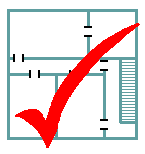Pebbles: Background and Overview In recent years, Computing Science has made significant progress using strongly-typed HLL's, although certain vital concepts, such as those needed for code generation and RPC marshalling have been missing until recently. Now solutions to these problems can be found in, for example FreshML and MetaML, and are being taken up by the wider community as extensions to Java and C++ (e.g. generic parametric types, strongly-typed reflection and meta-programming). However, there are fundamental design decisions for the future of truely Ubiquitous Computing that are best explored using practical deployment:
One of the main aims of the Pebbles programme is to explore these problems by building a prototype system. In the system as a whole, Pebbles are small computing objects that fulfill a well-described function. Appropriate methods for describing Pebbles are being explored: WSDL, XML, UML, predicate logic or free text? Pebbles are used by applications that are synthesised directly from Goals. Goals are created by human beings, either for immediate satisfaction (e.g. "Turn the lights on") or as programs for future execution (e.g. "Record the Simpsons this evening and charge it to Mary"). The work here is undertaken as part of the AutoHAN project, whereas at MIT it is part of Project Oxygen. The emphasis here in Cambridge UK is currently placed on control of delimited systems, such as a home or spacecraft. We started with a single, all-knowing controller, the Rule-Based Controller. Then we considered distributed execution of rules within a domain of interaction that is restricted by formal logical constraints. Next we shall allow rules/scripts to start operation in their own locally constrained domains and investigate the dynamic merging and division of the domains and how rules/scripts must be suspended or otherwise. Broad-brush Summary of Work TasksEnvisaged primary work tasks:
Envisaged secondary work tasks:
BeneficiariesOne of our aims is to influence the manufacturers of embedded devices that participate in a ubicomp networking and the providers of their embedded operating systems, middleware and tool chains. We wish them to use new software architectures, based on our ideas, that clearly separate detailed mechanism from application scripting, with a view to applying automated formal safety checks to detect potential conflicts or undesirable situations. We wish to facilitate lightweight scripting or 'programming' using a variety of input interfaces, yet have a common infrastructure for checking, interrogation and execution. Our technology looks as though it will be useful for those who implement industrial controllers and safety-critical systems. Although these systems are less dynamic, in terms of device population, than envisaged for ubicomp, the requirement for static analysis to predict future interaction is essentially the same. Equally, we wish to promote new methods for lightweight application scripting. These methods should be easy to use through relieving the author/user of many implementation decisions, but also amenable to automatic checking and validation. Multi-view programming has been explored in this context by Hague. Currently, declarative forms are being investigated in this project, either as Goals or as directly executable specifications using Push Logic. Bastani is extending UML to support reflexive APIs and dynamic scripting. |

END. Pebbles Main Page..